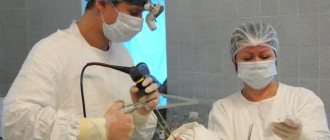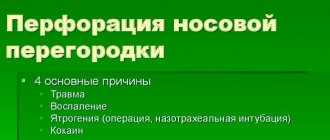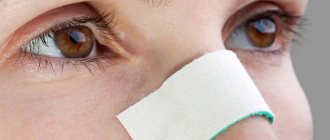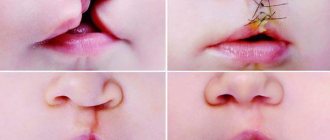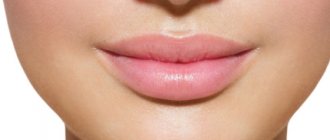Structure and functions of the nasal septum
The nasal passages are separated using a plate. In front, the septum has a quadrangular shape and consists of cartilaginous tissue. Below is the hard palate, behind is the ethmoid and sphenoid bones, and at the top is the frontal bone.
The nose performs a number of important functions:
- filtering of inhaled air;
- maintaining an optimal level of humidity;
- warming;
- odor recognition.
Violation of the structure of the plate can lead to partial or complete loss of some of them.
Causes of a deviated nasal septum
The complex structure of the septum makes it vulnerable and easily deformed.
The main reasons for plate shape violation may be:
- Injury. Half of the cases involve injuries to the facial part of the skull or nose. Most often, injuries occur at a young age. Deformation in a newborn may be the result of illiterate manipulations by the midwife or too rapid movement along the birth canal.
- Inconsistency in the growth of the bones of the facial part of the skull. This pathology is present in 30% of patients. Uneven development of parts of the nose disrupts its symmetry.
- Diseases - tumors, polyps, growth of the nasal concha. Chronic rhinitis can also be the cause - a person inhales air only through one of the nasal passages, which leads to deformation.
- Hereditary predisposition.
- Hypertrophy of the vomeronasal organ, which contains olfactory cells. Normally, it is atrophied, but in some cases it can increase, causing curvature.
Causes and types of curvature
Congenital and acquired causes of deviated nasal septum
A deviated nasal septum can be congenital or acquired.
There are several main reasons for this defect:
- Curvature that occurs during the period of active tissue growth. Since this part of the nose is made up of bone and cartilage, in some cases dissimilar tissues can grow at different rates. As a result, deformation or change in the shape of the septum occurs, and the formation of internal defects.
- Since the bridge is very thin, fragile and pliable, various neoplasms in the nose, for example, polyps or foreign bodies in the cavity, can cause it to deviate from the vertical and become crooked.
- Deformation can also occur as a result of the development of a strong inflammatory process that affects this part of the bone, or accompany some diseases associated with the destruction of bone tissue of the facial part of the skull (syphilis in the last stage, leprosy, and so on).
- Trauma is one of the most common causes of curvature. It can be caused by an accident or a bad fall, but most often it happens when a blow to the face causes injury or a broken nose. Men suffer from nasal injuries more often than women; athletes receive blows to the face with a crooked nose more often than people who do not engage in sports, tourism, or simply do not lead an active lifestyle.
It is not always possible to determine the curvature of the nasal septum by external signs, since what we see is a cartilaginous structure, and the septum itself is located deep in the nose. Therefore, a crooked nose does not always mean the presence of septal defects, and the curvature may well accompany a perfectly straight nose.
Symptoms
Symptoms of a deviated nasal septum
It should be noted right away that in most people this part of the skull is curved to one degree or another. It is very rarely completely smooth, but small defects do not manifest themselves as pathological phenomena. For its curvature to become noticeable, it must be quite intense.
A crooked nasal septum, the consequences of which may not appear immediately, may have “blurred” manifestations, or demonstrate obvious health problems.
The main symptoms of the pathology:
- Most often, there is a violation of breathing through the nose, and it can be bilateral or unilateral. The violation can be complete or partial, it depends on how severely the nasal passage is blocked. In most cases, this occurs after an injury when a piece of bone becomes dislodged or breaks off, completely or partially blocking breathing.
- Due to the deformation of the septum, noisy breathing and snoring occur during sleep. At the same time, both men and women, even children, can snore.
- A person suffering from curvature may have a chronic runny nose or its complicated forms - inflammation of the maxillary and frontal sinuses. This is due to the fact that the curvature of the nose does not allow the contents of the sinuses, especially purulent ones, to freely separate and come out. As a result, stagnation occurs, secondary infection occurs and serious chronic diseases develop.
- The hearing organs can also be affected - due to chronic infection, inflammation of the middle ear occurs. If the infection “settles” close to the septum, this can cause even greater deformation.
- Many patients note increased dryness of the mucous membranes, which is accompanied by irritation and frequent sneezing.
- If the septum is curved for a long time, polyps may form on it due to injury to the mucous membrane. They can be single or multiple. Their presence and size significantly complicate the course of the disease.
A crooked nose that is noticeable to the naked eye. All of these symptoms may not necessarily be diagnosed together. The most common reasons for visiting a doctor are frequent runny noses and breathing problems, especially under exertion.
Types and types of deviated nasal septum
A deviated nasal septum (the operation depends on the type of injury) can have varying degrees:
- Group 1 – slight slope from the center;
- Group 2 – the septum protrusion is located in the middle between the side wall and the central line;
- Group 3 – the curved plate touches the side wall.
There is also a more detailed classification that takes into account morphological, pathogenetic and clinical features:
- A one-sided ridge located vertically in the depths of the nasal cavity.
- Two protrusions located in a vertical plane on different sides of the partition (S-shaped bend).
- A small ridge in the front of the nose that does not interfere with free breathing.
- A crumpled plate with many fracture lines.
- There is a pronounced protrusion in the anterior part of the septum, the lower edge of the cartilaginous quadrangle is shifted back. Breathing is impaired.
- An ascending ridge, shaped like a saber, located on one side almost horizontally.
- Two almost horizontal protrusions located opposite each other on the front of the nose and in the middle section. There is a characteristic groove on one side.
In addition to the listed types, multifragmented deformities of the nose can be distinguished, when fragments of the septum are superimposed on one another at different angles.
Diagnostic measures
To make a diagnosis of a pathological curvature of the nasal septum, an experienced specialist needs only an external examination and anamnesis.
But in order to determine the extent of the pathological process that has arisen, and to avoid medical errors, the following diagnostic procedures are prescribed:
- X-ray examination is performed in 4 projections. This allows you to assess the condition of the nasal sinuses, as well as determine the presence of a bone abnormality.
- Computed tomography reveals the presence of changes in the posterior parts of the nose. In addition, it helps identify concomitant diseases of the ear, nose and throat.
- MRI. It is an informative type of research. Helps to identify the presence of formations of different origins or polypous growths.
- Rhinoendoscopy. It is performed using an endoscope using local anesthetics. This technique allows you to assess the condition and examine the posterior parts of the nose.
- Rhinoscopy . This type of examination allows you to assess the condition of the anterior part of the nose and the deep parts of the septum.
- Rhinometry allows you to identify an obstacle to the passage of inhaled air.
Symptoms of a deviated nasal septum
A curvature of the nasal septum (the operation is important due to the severe narrowing of the nasal passage) impedes the passage of air, the number of cilia on the ciliated epithelium decreases, which negatively affects the natural protection and cleansing of the mucous membrane. Lack of oxygen affects the activity of the entire body.
Most often, patients note the following signs of deformation:
- Breathing disorders, manifested in nasal congestion, the appearance of mucous discharge, sometimes mixed with pus, and a feeling of dryness. The symptom may affect only one side.
- Chronic inflammatory diseases of the nasal sinuses (sinusitis).
- Tendency to respiratory infections.
- Nosebleeds.
- Vasomotor rhinitis associated with the proliferation of the vascular network.
- Soreness in the facial area.
- Noisy breathing, snoring.
- Discomfort in the nose, itching, swelling of the mucous membrane.
- A deviated nasal septum often touches the trigeminal nerve, irritating it. This provokes regular migraines, respiratory spasms, chronic coughing, and sneezing.
- Fatigue, depression, decreased ability to concentrate and remember due to oxygen deprivation. Children may experience developmental delays, both physical and mental.
- Forced inhalation through the mouth leads to chronic pharyngitis, bad breath, and dry mouth. The air does not undergo purification and does not warm up, which poses a danger to the lower respiratory tract. The likelihood of developing bronchitis and pneumonia increases.
Don't miss the most popular article in the section: Cannula - what it is, how it is used in cosmetology and medicine.
Complications after surgery on the nasal septum
Complications after surgical treatment of nasal septum deformity are mainly due to the anatomical features of the patient’s facial skeleton and are rare. These include: nosebleeds, perforation (violation of the integrity) of the nasal septum, synechiae (fusion) of the nasal cavity. Most often, such complications are well corrected by surgical or conservative treatment.
We hope that this article will help you understand the importance of timely and qualified treatment for a deformed nasal septum. Preparation for the operation will take no more than a week, and you will have to feel the consequences and complications of impaired nasal breathing throughout your life. The choice is yours!
Medical doctors will help you solve problems associated with a deformed nasal septum. Timely and high-quality diagnosis of this and related diseases, effective methods of treating them, and the qualifications of our doctors are good helpers in restoring your healthy, clean nasal breathing. Remember, breathing is our life.
Make an appointment
Indications for surgery
The reason for contacting a surgeon may be:
- Frequent bleeding from the nose.
- Breathing noise and snoring that cause discomfort to the patient.
- Tendency to colds.
- Headache.
- Swelling of the mucous membrane.
- Sinusitis, allergic rhinitis.
Preparatory stage
To clarify the diagnosis, you need to contact an otolaryngologist.
The inspection may include:
- Assessing the appearance of the nose. This stage allows you to identify serious deformations.
- Testing the strength of inhalation and exhalation through each nostril and the ability to smell.
- Rhinoscopy – examination of the nasal cavity using special equipment. To do this, a dilator is inserted into the nostrils, and the mucous membrane is probed with a thin probe to assess the presence of tumors, ulcers, and polyps. When penetrating through the oral cavity, it is possible to detect hypertrophy of the posterior side of the nasal concha.
- Endoscopy, which involves a more detailed examination of the mucous membrane, is performed using local anesthesia. Through a probe with a video camera you can clearly see the lower shell.
- CT scan showing the presence of spines and ridges on the septum.
Before the operation you must:
- for men to shave;
- stop drinking alcoholic beverages and smoking;
- Do not take medications that affect the rate of blood clotting.
Two weeks before surgery, you should undergo a number of tests:
- blood for syphilis, human immunodeficiency virus, viral hepatitis;
- determination of Rh factor and blood group;
- fibrinogen concentration, platelets, coagulation level;
- urine analysis for the presence of protein, sediment composition;
- blood test - leukocyte formula, hemoglobin, leukocytes, erythrocytes and platelets.
Anesthesia
Depending on the location of the deformed area, local or general anesthesia is used:
- Local anesthesia acceptable if the curvature does not affect bone tissue. The mucous membrane is moistened with a desensitizing solution using a spray or tampons.
- General anesthesia. In children and patients with deformation of bone structures, the operation is performed in a state of anesthesia.
Methods of surgical treatment
Septoplasty is performed using several methods. The choice of one method or another depends on the type of deformity, as well as on the policy of the clinic where the patient is observed.
Operation Killian
It does not require any incisions on the skin, therefore eliminating the formation of scars. Using a small scalpel, incisions are made in the perichondrium and mucosa on both sides in turn. An anesthetic is injected under the perichondrium, and through the incisions made, the membrane is shifted to the desired position.
If there are spines or ridges, the detachment is done only around them so as not to disturb the structure of the mucosa over the projections. After this, the septum is straightened using a mechanical method, the elevations are cut off and the deformed areas are excised.
The aligned nasal septum is fixed with tampons, pressing the mucous membrane to the bones and cartilage. A sling dressing is often recommended.
Redressation of the septum
Using a scalpel, an incision is made into the mucous membrane and perichondrium in one of the passages of the nose. The separation is done only from the side of the incision. From the same edge, the cartilage is dissected in four places so that its deformed part is connected only to the perichondrium, mucous membrane, and also to the periosteum of the second nasal meatus.
After this, the septum is cut at the point where its base is curvature. After this, the nasal septum becomes mobile and takes its natural position, in which it is secured with tampons.
Mobilization of the septum
The nasal septum is broken in several places using special surgical instruments. After this, the fragments are stabilized and the plate is straightened.
In most cases, dissection of the mucosa is not required. If it becomes necessary to make incisions, they are stitched with self-absorbing suture material - catgut.
Circular resection
If, after mobilization, the quadrilateral cartilage has not acquired sufficient mobility and the septum has not straightened, a circular incision is made and a thin layer of cartilage is cut around the quadrilateral. After this, the bony base of the septum is redressed.
Partial resection
One nasal passage is operated on. The mucosa is dissected to the cartilage along almost the entire length of the septum. Using a special tool, the membrane is separated from the perichondrium. Through the resulting incision, the cartilage is dissected so that it becomes possible to separate it from the mucous membrane on the opposite side.
After this, the deformed parts of the septum are removed using scissors, and the mucous membrane is put in place and fixed with tampons. If bleeding is profuse, tampons are impregnated with a hemostatic compound.
Resection-reimplantation
Recognized as the most advanced method of septoplasty. The deformed cartilage plate is cut using a metal knife.
After this, the pieces are flattened with a special device, giving them the correct shape, returned to their original place and fixed.
Laser septoplasty
A deviated nasal septum (an operation done with a laser) is corrected by a surgeon using equipment that allows you to regulate the depth of penetration of radiation into the tissue.
There is practically no blood released during the process, since the laser “seals” the damaged vessels. The cartilage tissue that violates the shape of the septum is evaporated, after which the plate is fixed with a plaster bandage and gauze swabs.
Advantages of this technique:
- antiseptic effect;
- stimulation of tissue regeneration and immunity;
- bloodlessness;
- minimal trauma;
- short recovery period.
Endoscopic septoplasty
Refers to low-traumatic, gentle methods. Resection is performed inside the nose on the mucous membrane, which helps prevent the formation of scars on the facial skin. The duration of the operation is 30-40 minutes.
During the process of detachment of the mucous membrane, its integrity is maintained, with the exception of injuries in which the damaged areas must be removed to give the septum a vertical position.
Don’t miss the most popular article in the section: Vera Alentova after plastic surgery - the latest photos, what operations were performed, how the star has changed.
Basic surgical treatment methods
Septoplasty
Septoplasty is a type of rhinoplasty (nose job), an operation to correct the shape of the nasal plate. Septoplasty is usually prescribed after 17-18 years of age. By this time, the nasal septum is fully formed. For certain indications, surgery may be performed earlier. The disadvantage of surgery at an early age is that the nasal plate may become distorted again.
The operation lasts no more than 2 hours and is performed under local or general anesthesia. During this time, the doctor removes the deformed areas and applies absorbable sutures. At the end of the procedure, turundas are inserted into the nasal passages. They help stop bleeding and prevent infection.
In addition to classical septoplasty, which is aimed at giving the septum an anatomically correct shape, nasal plastic surgery can also be performed. Rhinoplasty for a deviated nasal septum will help not only get rid of annoying breathing problems, but also correct the tip of the nose or correct the hump.
Laser septoplasty
With this type of septoplasty, correction occurs by heating the nasal septum with a laser and giving it the required shape. This operation takes no more than 15-20 minutes and is performed under local anesthesia.
Benefits include:
- non-traumatic;
- painlessness;
- no bleeding;
- slight swelling;
- there is no need to place the patient under long-term observation.
This method of correction is much better than traditional septoplasty, but its use is limited. Only the cartilaginous part of the septum is amenable to laser treatment, and in most cases the bone tissue also needs correction. In addition, this operation is not free and you will have to pay at least 20,000 rubles to carry it out.
Rehabilitation
After the operation is completed, tampons with antibacterial and hemostatic compounds are placed in the nose for a day. If the operated area continues to bleed, the used tampons are replaced with new ones and left for another 1 day. If necessary, the nose is additionally fixed with a gel bandage. During this period you have to breathe through your mouth.
The following symptoms may occur:
- pain in the upper jaw;
- migraine;
- dry mouth and thirst;
- increased body temperature;
- dizziness, loss of strength, drowsiness.
During the rehabilitation period, doctors recommend taking antibiotics, hemostatic medications, and pain-relieving medications.
For successful tissue healing it is necessary:
- drink drinks that are not too hot;
- do not take a warm bath or hot shower;
- do not blow your nose forcefully;
- after removing the tampons, rinse the nasal passages every day with antiseptic and saline solutions;
- For a month after the operation, you should refrain from going to the bathhouse, heavy physical activity, and drinking alcohol.
Typically, patients spend the first 5-6 days after correction of the septum in the hospital, but discharge is possible already on the second day after removal of the hemostatic tampons, subject to daily visits to the doctor.
Free breathing is not restored immediately; at first, swelling remains in the nasal passages. Most patients regain the ability to fully breathe and smell within 7 days, but for some, recovery takes a month.
Video when you need to do the operation:
Postoperative period
After the operation, the patient every day for qualified care of the postoperative wound (it is inside the nasal cavity, but it exists!!) and the nasal mucosa.
It usually takes 7–14 days before the postoperative swelling of the mucous membrane disappears and the formation of crusts stops. At this time, the doctor at the appointment carries out the necessary procedures to remove clots and crusts from the nose, prevent infection, and reduce postoperative swelling of the mucous membrane. Antibiotics and irrigation of the nasal cavity with saline solutions such as Aqua-Maris, Aqualor, etc. are usually prescribed. In addition, at home, the patient can rinse the nose with sterile saline (sold in a pharmacy without a prescription) using a plastic syringe without a needle to soften the crusts and better mucus discharge.
For all patients who have undergone surgery on the nose and paranasal sinuses, it is very important to remember the rules of conduct after surgery :
- The patient should not blow his nose on the first day after surgery and removal of tampons, as this can cause bleeding and the formation of a hematoma, perforation of the nasal septum.
- After the operation and removal of tampons, it is mandatory to perform a nasal toilet at least once a day for a week, which should be performed by an ENT doctor at a hospital or clinic.
- Return to work is usually possible 7-14 days after surgery.
- It is advisable to avoid strenuous physical activity, sports, and visits to the bathhouse or sauna for 4-5 weeks after surgery.
Complications
A deviated nasal septum (correction surgery is quite simple) is rarely accompanied by complications.
Unpleasant symptoms during the rehabilitation period can manifest themselves as follows:
- bloody discharge from the nose;
- poor sense of smell;
- hematoma is a blood-filled cavity between the mucous membrane and cartilage or bone tissue;
- inflamed ulcers;
- unnatural, sinking shape of the bridge of the nose;
- adhesions in the nose;
- chronic sinusitis;
- opening connecting the nasal passages.
Types of nasal septum correction
Laser surgery to correct the nasal septum is performed using two methods:
- Corrective – the laser beam heats up the cartilage, making it flexible. The cartilage tissue is given the required shape, secured with a cotton swab. This method can be used only if there is no deformation of the bone tissue. The operation lasts only 20 minutes. It is safe, there is no risk of injury, no bleeding. After the procedure, the patient can go home immediately. It is worth considering that this type of treatment is rarely used in practice, since it is only suitable for straightening isolated cartilage.
- Plastic - in essence, this method is similar to classic nose surgery. The advantage of laser surgery for a deviated nasal septum is that the beam seals the vessels, so blood loss is significantly lower than when working with a scalpel.
IMPORTANT! The laser cannot be used in all cases. The laser beam affects only cartilage tissue, but it is powerless against bone tissue. Also, it is not able to remove ridges and thorns, but is prescribed only to give the correct shape. In addition, the laser is powerless in cases of deviated septum due to the opportunistic factor.
See how a septum is corrected with a laser:
Classic surgical correction of the nasal septum is an intervention using a scalpel with or without an endoscope. Depending on the complexity of the deformation, several operations are distinguished:
- Redressing the nasal septum - an incision through one nasal passage with dissection of the cartilage tissue at the site of deformation;
- Bilateral dissection of cartilage tissue. All work is carried out under control through an endoscope. The incisions are made inside the nasal passages, so no scars are left.
See how the operation is performed surgically:
Radio wave correction is a quick and painless procedure performed with the Surgitron apparatus and an endoscope. Duration – 1-1.5 hours. Rehabilitation – no more than 3 days in hospital. The radio beam evaporates the cells, the capillaries close immediately, so there is no bleeding. The development of infection is almost impossible, since local disinfection with radio waves occurs at the incision site. Using the beam, you can work out an area in great detail without touching neighboring tissues. This is very convenient, since the affected area is significantly reduced.
Ultrasound correction is used in cases where the curvature is minimal. The method is called ultrasonic cristotomy. A special tool - an ultrasonic saw - removes the ridges and spines of the septum. But defects should be minimal.
Contraindications for surgical treatment
Septoplasty is prohibited in the following cases:
- The presence of a concomitant inflammatory process in an acute form or in an aggravated chronic form.
- Coagulopathy is a blood clotting disorder.
- Tuberculosis of the lungs and upper respiratory tract.
- Menstrual bleeding and the first week after it.
Deviation of the nasal septum cannot be done during menstrual bleeding and the first week after it. The operation is done later. - Atrophic changes in the epithelium of the nasal septum.
- Psychical deviations.
- Decompensation of somatic pathologies.
- The patient's age is over 50 years or younger than 16-18 years.
Treatment
A crooked nasal septum is an anatomical problem, so it is impossible to straighten the plate with medication. If, as a result of its deformations, breathing and hearing disturbances are noted, a disorder of smell develops, the middle concha is additionally enlarged, or hypertrophy of the lower one is observed, we will definitely talk about surgical interventions, mainly traditional ones - septoplasty or endoscopic surgery. In rare cases, a deviated septum can be corrected with a laser.
Treatment without surgery
Conservative therapy can be aimed at eliminating chronic inflammation, polyps, adenoids (a consequence of a deviated septum), helping to alleviate the condition of allergic diseases, restoring breathing and strengthening the immune system. However, correcting a crooked septum is impossible, so doctors question the effectiveness of such treatment. Mostly experts can advise:
- removal of adenoids, polyps;
- osteopathy (manual therapy);
- a long course of drugs to eliminate swelling.
- Causes of ectopic pregnancy in women, signs and development in the early stages
- How to get a Veteran of Labor
- Lytic mixture for children against fever. Composition and dosage of the lytic mixture in tablets and ampoules
Operation
The doctor may recommend surgical correction of the curvature in case of serious deviations in the development of the cranial bones, which provoke a large number of complications: among them, concha hypertrophy, persistent sinusitis, and the inability to breathe through a narrowed nostril. Surgery is performed only on persons over 16 years of age (exceptions are possible). Resection of the nasal concha can be performed with an endoscope, which is less painful. In case of severe injuries, rhinoplasty is performed simultaneously with classical surgery.
Laser chondroseptoplasty
Classic septoplasty is performed only in cases of severe forms of curvature, and for minor deformities the doctor may suggest laser treatment. This method is used only if it is necessary to straighten the cartilage tissue - the laser will not perform resection of spines and correct the bending of bone tissue, nor will it help with traumatic curvature. According to reviews, the procedure is painless, but it is not recommended for children and elderly people.
Is it possible to treat a deviated nasal septum without surgery?
There are no reliable methods to straighten the septum without resorting to surgery. Using alternative methods aimed at relieving the symptoms of deformity, it is important to contact experienced specialists so as not to aggravate the situation.
The following methods are most widespread among opponents of the operation:
| Name of the technique | Description |
| "Butterfly" | This is a plastic clip that attaches to the back of the nose. The duration of treatment is several hours a day. The device is used to narrow and straighten the cartilaginous dorsum of the nose. A side effect may occur - mucus stagnation in the sinuses and the development of sinusitis. |
| Osteopathy | Manual effects on cartilage tissue and facial bones. Some experts claim that this way you can achieve complete straightening of the septum. It is important to remember that this type of correction is not suitable for all types of deformities, and in order to get a noticeable result, you will have to undergo a long course of treatment. |
| Conservative tactics | It helps if the cause of the curvature is polyps, severe swelling of the maxillary sinus and other pathologies of the nasopharynx. When the provoking factors disappear, the septum partially or completely moves to its proper place. To monitor the result, an x-ray should be taken 2-3 months after completion of treatment. |
Before surgery
It seems that it was not so long ago, but I can’t remember the exact date - it was something around January-February. It was cold outside, there was snow, the weather was so-so, and on one of these “beautiful” days I fell ill - I caught a cold.
There seems to be nothing unusual - everything is as always, slight chills, fever, runny nose and cough, I think everyone has encountered this at least once.
I treated myself as usual, some tea with herbs, raspberry jam, cold powder and so on - everything was fine, but my nose was constantly stuffy . I went away with the drops for about a month and only then went to the doctor, because it was already starting to worry me - as they say, a cold goes away on its own in 2 weeks, and with additional treatment in 14 days, like it or not, everything should have gone away.
The doctor, not understanding what’s wrong, prescribes me other drops and sends me to physical therapy. procedures (warming up there and all that) - at first it became a little easier, but then my nose became completely stuffy.
I went to the doctor again, and now he prescribes me more expensive drops - to no avail.
So I suffered for another two months and then went to another doctor. Having told him about what has already been done to me, this doctor sends me for laser - this is an expensive treatment, but your referral is free and it will definitely help.
- Thank you
- My pleasure
You’re really welcome, once again I missed it - the treatment didn’t help ! I come again - now they offer me to take hormonal drops and tablets, they say, this is exactly your case and, alas, there is no other way. There was nowhere to go, I had to shell out a lot of money.
After a course of such treatment there is still no result. I got the impression that the doctors are trying to find out what is wrong with me using the “scientific poking” method and have no idea how to help me.
For some time I did not resort to the services of doctors and continued to use drops, which somehow made my breathing easier. Further more, because of problems with my nose, I even began to snore at night - this was still not enough. It got to the point that I even had to wake up in the middle of the night to take the “next dose” of the medicine.
A few months later, I again decided to resort to the help of health authorities, since this no longer fit into any framework. I went to the ENT specialist and demanded a referral for a full examination or to a hospital in another city since they couldn’t do anything. Omitting some details, it turned out that only surgery would help me - it was necessary to break my nasal septum, which, as it turned out, was curved.
How so, HOW? How did I breathe normally for 24 years, and then suddenly I have a crooked septum and it’s all about that? I was outraged and couldn’t believe it, or couldn’t come to terms with it, if that was more appropriate.
Before going to the hospital, I had to visit a bunch of doctors from A to Z, at the same time I even had to take care of my teeth, patch up existing holes, and only after that, with all the necessary tests, I went to another hospital, where I was supposed to be examined by the doctor who would perform the operation .
This time you were lucky - you guessed right! The woman who examined me confirmed the need for surgery and told me everything in detail.
I thought I would be admitted on the same day, but it turned out that there were no free beds in the ENT department wards and this event had to be postponed for a week. In principle, I was glad about this, since I was not yet ready and equipped with the latest technology.
That evening, I called several acquaintances, got hold of a laptop and a 3G modem for my “journey,” so that I could stay in touch and at least keep myself occupied with something.
Is it possible to prevent deviated nasal septum?
In order to prevent deformation of the central plate of the nose, it is necessary:
- promptly treat ENT diseases;
- avoid traumatic activities;
- strengthen the immune system.
Don't miss the most popular article in the section: How and why ribs are removed - effectiveness, photos before and after surgery.
Where can I have the operation and how much does it cost?
The total cost of septoplasty is calculated depending on several factors:
- types of surgical intervention;
- type of anesthesia;
- degree of nasal deformation;
- list of measures aimed at restoration.
A deviated nasal septum can be corrected free of charge by contacting the clinic at your place of registration. The ENT specialist will issue a referral to a regional hospital, where you will need to stand in line and undergo all the required tests. After some time, an invitation for surgery will follow.
The disadvantage of this route is that you cannot choose your own surgeon. The specialist may be a beginner, although interns are usually supervised by more experienced doctors.
The cost of a standard operation, which also includes a hospital stay, is about 20,000 - 100,000 rubles. Often the price is increased, explaining this by using wave scalpels, but given the minimal size of the incisions, the use of expensive equipment may not be justified.
Prices for laser septoplasty vary from 30,000 to 40,000 rubles.
The operation to correct the curvature of the nasal septum, as well as the rehabilitation period, under the supervision of a qualified specialist, takes place without serious complications. If there are indications, you should not postpone surgical intervention and endure unpleasant symptoms. After surgery, it is important to monitor the healing process in order to detect abnormalities in time.
Article design: Oleg Lozinsky
Where is the best place to have septum plastic surgery?
In public clinics, correction of the nasal septum is carried out using the Killian method. It is worth mentioning that this is an outdated technique, it is quite traumatic.
In recent decades, many modern minimally invasive techniques have appeared that can reduce the rehabilitation period:
- endoscopic septoplasty;
- laser
All these types of interventions are not carried out under the compulsory medical insurance policy.
It is up to the patient to decide which clinic to go to, paid or free. Money is on one side of the scale, health is on the other. Of course, if there are no financial possibilities, then there is no choice, but if there is money, then it is better to do the operation for a fee. Plastic clinics that do not operate under compulsory medical insurance have the latest equipment, which can be used to perform interventions with the least amount of tissue damage.
If you decide to save money, you need to do the following:
- Visit an ENT specialist.
- Get tested.
- Receive a referral on Form 057 for surgery.
Related article: Is removal of papillomas included in the compulsory medical insurance policy
? The surgeon decides what type of anesthesia to choose, local or general.
Note! You can get septoplasty under compulsory medical insurance at the National Medical Research Center of Otorhinolaryngology "FSBI NMITSO FMBA of Russia", at the Institute of Otorhinolaryngology named after. L. I. Sverzhevsky.
In general, we would like to note that free does not mean bad. The main thing is to choose a qualified surgeon, then the operation will be successful.

